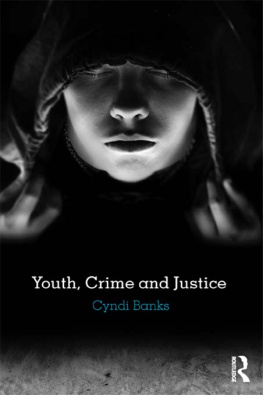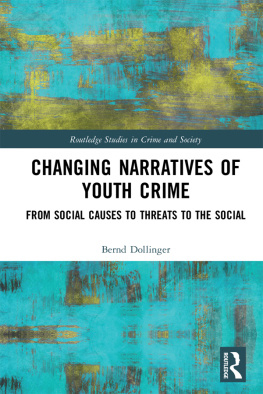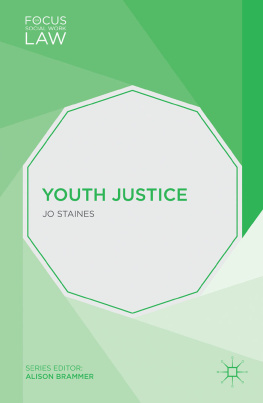Youth, Crime and Justice
Youth, Crime and Justice takes a critical issues approach to analyzing the current debates and issues in juvenile delinquency. It encourages readers to adopt an analytical understanding encompassing not only juvenile crime, but also the broader context within which the conditions of juvenile criminality occur. Students are invited to explore the connections between social, political, economic and cultural condi-tions and juvenile crime.
This book engages with the key topics in the debate about juvenile justice and delinquency:

juvenile institutions

delinquency theories

gender and race

youth and moral panic

restorative justice

youth culture and delinquency.
It clearly examines all the important comparative and transnational research studies for each topic. Throughout, appropriate qualitative studies are used to provide context and explain the theories in practice, conveying a powerful sense of the experience of juvenile justice. This accessible and innovative textbook will be an indispensable resource for senior undergraduates and postgraduates in criminology, criminal justice and sociology.
Cyndi Banks is Professor of Criminology and Criminal Justice at the Northern Arizona University. Her recent publications include Criminal Justice Ethics: Theory and Practice (Sage, 2012), Alaska Native Juveniles in Detention (Mellen Press, 2009), Punishment in America: A Reference Handbook (ABC-CLIO, 2005) and Developing Cultural Criminology: Theory and Practice in Papua New Guinea (University of Sydney, 2000).
Youth, Crime and Justice
Cyndi Banks
First published 2013
by Routledge
2 Park Square, Milton Park, Abingdon, Oxon OX14 4RN
Simultaneously published in the USA and Canada
by Routledge
711 Third Avenue, New York, NY 10017
Routledge is an imprint of the Taylor & Francis Group, an informa business
2013 Cyndi Banks
The right of Cyndi Banks to be identified as author of this work has been asserted by her in accordance with sections 77 and 78 of the Copyright, Designs and Patents Act 1988.
All rights reserved. No part of this book may be reprinted or reproduced or utilized in any form or by any electronic, mechanical, or other means, now known or hereafter invented, including photocopying and recording, or in any information storage or retrieval system, without permission in writing from the publishers.
Trademark notice: Product or corporate names may be trademarks or registered trademarks, and are used only for identification and explanation without intent to infringe.
British Library Cataloguing in Publication Data
A catalogue record for this book is available from the British Library
Library of Congress Cataloging in Publication Data
Banks, Cyndi.
Youth, crime and justice / Cyndi Banks.
p. cm.
Includes bibliographical references and index.
1. Juvenile delinquency. 2. Juvenile justice, Administration of. I. Title.
HV9069.B294 2013
364.36dc23
2012035850
ISBN: 9780415781237 (hbk)
ISBN: 9780415781244 (pbk)
ISBN: 9780203583968 (ebk)
Typeset in ScalaSans
by Keystroke, Station Road, Codsall, Wolverhampton
For James
Contents
chapter 1
Introduction
This is a book about current debates and issues in juvenile delinquency that takes a critical issues approach. It is aimed at senior undergraduates in criminology, criminal justice and sociology, and encourages readers to adopt an analytical understanding that encompasses not only juvenile crime but also the broader context within which the conditions of juvenile criminality occur. In articulating the connections between social, political, economic and cultural conditions and juvenile crime, this book goes beyond the conventional approaches to juvenile delinquency commonly found in such texts. Also, and rarely found in this field, the book makes significant use of appropriate qualitative studies to contextualize, provide explanations and meaning, and to convey a powerful sense of the experience of juvenile justice.
While this book surveys topics like juvenile institutions and delinquency theories that are ordinarily found in juvenile justice textbooks, it also broadens and deepens the debate about juvenile justice and delinquency by engaging with the topics of youth and moral panic, restorative justice and youth culture and delinquency. Augmenting the customary field of subject areas in this way enhances teaching approaches that combine issues in youth culture with more conventional subject matter such as the juvenile justice system and delinquency theories. The text offers a contemporary perspective on each topic that takes account of all important research studies, and engages with relevant comparative and transnational research studies.
This chapter provides a historical perspective of the development of the concept of juvenile delinquency and examines how the discourse of delinquency has changed over the historical record. It sets a foundation and context within which the subject matter of the book is located.
Fundamental transformative events and conditions in the development of delinquency have been: the social construction of delinquency over time; the parens patriae doctrine; the child-saving movement; and the creation of the Juvenile Court as a specialist court for adjudicating both juvenile criminality and cases of non-criminal dependency known as status offenses. These issues are reviewed in the following sections.
Constructing juvenile delinquency
Discourses concerning juvenile delinquency relate to specific sociohistorical periods. Understanding how those discourses originated and developed and the social forces and movements that prompted those discourses is central to comprehending juvenile justice development. For example, an under-standing of the concept of juvenile delinquency is incomplete without first appreciating how the concept originated, who originated it and how modern definitions depend so much on outdated assumptions about youth. As Muncie (2009: 45) notes, the historical account of juvenile justice up until the 1970s was an idealist history that focused on individual acts of prominent persons which suggested that juvenile justice followed a trajectory from savagery to reformation. Delinquency was defined by reference to poverty and neglect rather than by reference to actual acts of delinquency which would ordinarily constitute crimes.
From the 1970s revisionist histories challenged these accounts, and focused on a wide range of social, economic and political factors that are now seen as critical elements in the development of juvenile justice policy. The humanitarian and reformist child savers are now seen less as saviors of children in trouble with the law and more as a distinct class of individuals pursuing a broad range of goals, including the transmission of middle-class values, racist thinking about immigrants and idealizations of the family and rural life.
 juvenile institutions
juvenile institutions delinquency theories
delinquency theories gender and race
gender and race youth and moral panic
youth and moral panic restorative justice
restorative justice youth culture and delinquency.
youth culture and delinquency.






